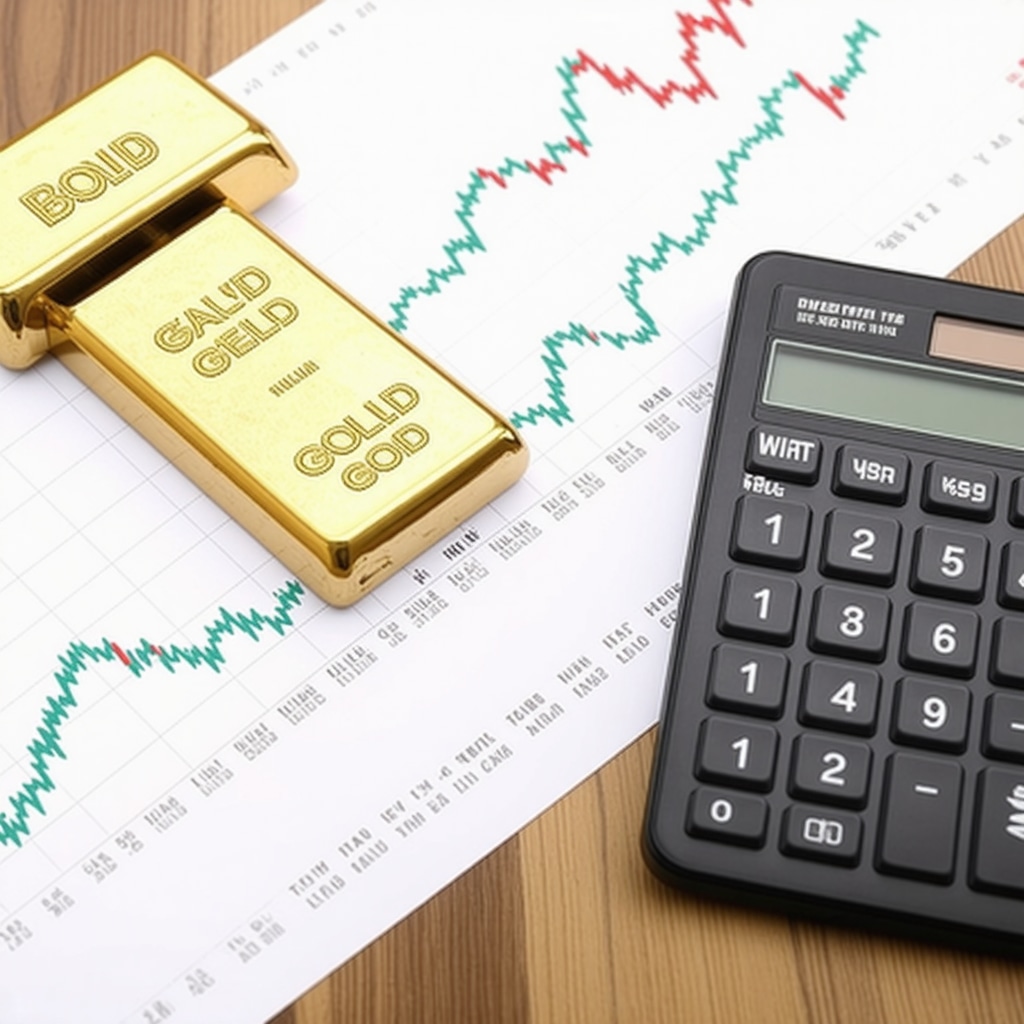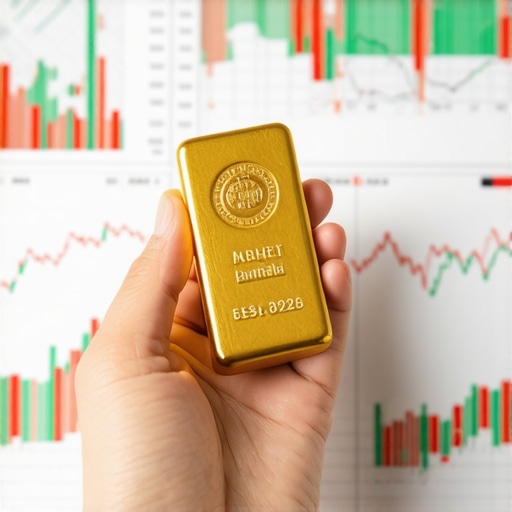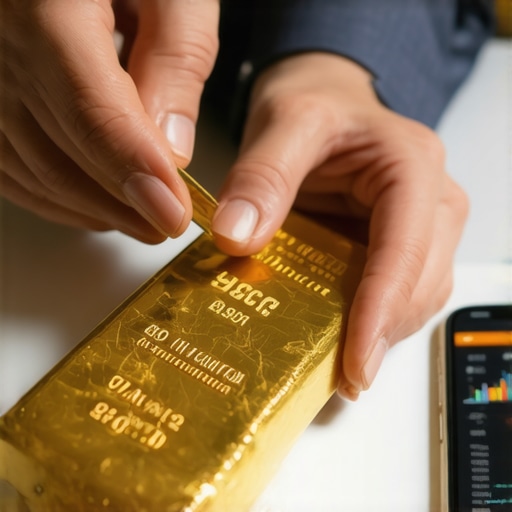Unlocking the Golden Gateway: Why Start Investing in Gold?
Gold has long been revered as a timeless store of value and a reliable hedge against economic uncertainty. For beginners, stepping into the world of gold investing might seem daunting, but understanding its unique role can transform your investment approach. Unlike stocks or bonds, gold offers a tangible asset that often moves independently of traditional markets, making it a strategic addition to diversify your portfolio and preserve wealth.
Charting Your Course: Essential First Steps to Gold Investment
Before diving into purchasing gold, it’s vital to develop a well-informed strategy. Start by assessing your financial goals and risk tolerance. Are you aiming for long-term wealth preservation or short-term market gains? Establishing this clarity guides whether you opt for physical gold, such as bars and coins, or financial instruments like ETFs and mutual funds. Beginners often benefit from starting with gold ETFs, which provide exposure without the complexities of storage and security.
Physical Gold vs. Digital Gold: Weighing Your Options
Investing in physical gold involves buying bars, bullion, or coins that you can hold in your hand. This form offers direct ownership and immunity from digital market risks but comes with challenges like safe storage and potential liquidity constraints. Conversely, gold ETFs and mutual funds offer ease of trading and diversification but rely on third-party management and carry market risks. Understanding these nuances helps tailor your investment to your comfort and financial landscape. For a comprehensive guide, see our detailed article on Physical Gold Investment Benefits Over Digital Alternatives.
Mastering the Market: How to Analyze Gold Price Movements
Gold prices fluctuate due to a complex interplay of factors including geopolitical tensions, currency strength, inflation rates, and central bank policies. Beginners should cultivate a habit of monitoring key indicators such as the U.S. dollar index, inflation data, and global economic stability. Tools like chart analysis and trend spotting can demystify price movements, enabling smarter entry and exit points. Our beginner-friendly resource How to Analyze Gold Price Movements: A Beginner’s Guide offers valuable insights to sharpen your market acumen.
What Are the Risks Every New Gold Investor Should Understand?
While gold is traditionally a safe haven, it is not immune to risks. Price volatility, storage costs for physical gold, and market liquidity can impact returns. Additionally, timing your investment poorly or falling prey to counterfeit products are pitfalls beginners must vigilantly avoid. Diverse gold investment strategies, including combining physical gold with ETFs or mining stocks, can mitigate these risks by balancing exposure and liquidity.
Taking the Leap: Where and How to Buy Your First Gold
Purchasing gold from reputable dealers is paramount. Verify credentials, check reviews, and compare prices to avoid scams. Beginners may find gold coins like the American Gold Eagle or Canadian Maple Leaf appealing due to their liquidity and recognition. For those considering retirement portfolios, exploring gold IRAs can be a smart move, with detailed steps available in our guide Your Guide to Opening a Gold IRA in 2025: Step-by-Step.
Starting your gold investment journey requires patience, knowledge, and strategic planning. Share your experiences or questions below to join a community dedicated to mastering gold investments and securing financial futures.
For authoritative insights on the enduring value of gold, consider the analysis from the World Gold Council, an industry leader providing comprehensive market data and research on gold’s role in modern investing (World Gold Council – Gold Demand Trends).
Decoding the Impact of Central Banks on Gold Prices
Central banks play a pivotal role in shaping gold markets globally. Their purchasing and selling activities can significantly influence gold’s supply-demand dynamics and price trends. In recent years, increased acquisitions by central banks, especially in emerging economies, have contributed to sustained upward pressure on gold prices. For investors, understanding these movements is crucial, as central bank policies often signal broader economic shifts that affect gold’s appeal as a safe-haven asset.
Monitoring central bank gold reserves and their quarterly reports can provide valuable foresight for anticipating market fluctuations. Moreover, geopolitical developments influencing monetary policy often coincide with changes in central bank gold buying patterns. For an in-depth perspective, refer to our article on How Central Bank Gold Purchases Affect Price Trends in 2025.
Integrating Gold Mining Stocks into Your Portfolio
Beyond physical gold and ETFs, gold mining stocks present a compelling avenue for investors seeking leveraged exposure to gold price movements. These stocks often outperform gold bullion during bullish phases due to operational leverage but can be more volatile. Evaluating mining companies requires analyzing production costs, geopolitical risks in mining regions, and management efficiency.
For those with a higher risk tolerance and an eye for growth, diversifying with select gold mining stocks can enhance returns and provide dividend income. To explore promising options and strategic approaches, explore our guide on Gold Mining Stocks to Watch for Growth in 2025.
How Can Investors Balance Gold’s Role as a Safe Haven and Growth Asset?
This question sits at the heart of sophisticated gold investing. Gold is traditionally viewed as a defensive asset protecting wealth during market downturns, yet certain gold-related investments offer growth potential. Balancing these roles requires a nuanced approach combining physical assets, ETFs, and mining stocks aligned with your financial objectives and risk appetite.
Allocating a core position in physical gold or gold ETFs provides stability and liquidity, while selective investment in mining equities can capture upside during market rallies. Regular portfolio reviews and responsiveness to macroeconomic indicators are critical in maintaining this balance. For a strategic comparison, see Gold vs Stocks in 2025: Which Asset Wins for Growth.
Leveraging Advanced Gold Trading Techniques
Experienced investors often use sophisticated trading strategies to maximize gold investment returns. Techniques such as futures trading, options strategies, and algorithmic analysis allow for capitalizing on short-term price movements and hedging risks. While these methods require deeper market knowledge and risk management skills, they can significantly enhance portfolio performance when executed correctly.
Beginners interested in advancing their expertise should consider educational resources and simulators before engaging in active trading. Our comprehensive article Master Gold Trading Techniques and Beat Market Challenges offers practical insights for those ready to elevate their trading tactics.
We invite you to share your thoughts or questions about integrating these advanced strategies into your gold investment plan. Engaging with the community can provide diverse perspectives and real-world experiences to help refine your approach.
For authoritative data and further reading on gold market dynamics, the World Gold Council remains an indispensable resource. Their latest reports on global demand and investment trends deepen understanding and inform decision-making (World Gold Council – Gold Demand Trends).
Harnessing Volatility: Advanced Risk Management Techniques in Gold Investing
Volatility in gold markets, often viewed as a double-edged sword, presents both risks and opportunities for seasoned investors. Mastering volatility requires more than just reacting to price swings; it demands a sophisticated framework of risk assessment and dynamic portfolio adjustments. Techniques such as employing stop-loss orders on gold ETFs or mining stocks can protect capital during sharp declines, while staggered entry and exit points allow capturing gains amid fluctuating prices.
Moreover, integrating gold with complementary assets like inflation-protected securities or foreign currencies can further smooth portfolio volatility. This multi-asset hedging strategy reduces the impact of sudden market shocks that may disproportionately affect gold prices. Investors leveraging these approaches often consult quantitative models that incorporate historical volatility, correlation matrices, and macroeconomic indicators.
What Quantitative Models Best Predict Gold Price Movements Amid Global Uncertainties?
Quantitative analysis plays a critical role in forecasting gold price trends, especially under complex and rapidly changing global conditions. Models such as GARCH (Generalized Autoregressive Conditional Heteroskedasticity) effectively capture time-varying volatility patterns in gold prices, accommodating sudden spikes due to geopolitical events or economic data releases. Meanwhile, machine learning techniques, including random forests and neural networks, have emerged as powerful tools to analyze multidimensional datasets encompassing currency fluctuations, interest rates, and central bank policies.
These models outperform traditional linear regressions by adapting to non-linear relationships and structural breaks in the market. However, their accuracy hinges on high-quality, timely data and expert interpretation to avoid overfitting or misclassification. Investors seeking to harness these advanced predictive tools should collaborate with data scientists or utilize specialized platforms offering algorithmic trading modules tailored to precious metals.
For further exploration of predictive analytics in gold investing, the CFA Institute’s research on machine learning applications in precious metals forecasting provides an authoritative, in-depth examination.
Demystifying Gold Options and Futures: Leveraging Derivatives for Strategic Advantage
Gold derivatives, including options and futures, offer investors amplified exposure and hedging capabilities but require a nuanced understanding of contract specifications, margin requirements, and market psychology. Futures contracts obligate the purchase or sale of gold at a predetermined price and date, enabling price locking but also exposing investors to margin calls during adverse price moves.
Options provide asymmetric risk profiles—buyers can limit downside risk to the premium paid while retaining upside potential. Strategies like covered calls or protective puts can generate income or shield portfolios from downside volatility. Yet, the complexity of options greeks (delta, gamma, theta, vega) demands a disciplined approach to position sizing and risk monitoring.
Developing proficiency in these instruments often involves simulated trading environments and continuous education. Our detailed guide Advanced Gold Derivatives Strategies for Investors in 2025 elaborates on tactical implementations and risk mitigation for these powerful tools.
Integrating ESG Considerations into Gold Investment Decisions
Environmental, Social, and Governance (ESG) factors are increasingly influential in gold investment evaluations, reflecting a broader shift towards responsible investing. Mining companies with robust ESG practices often demonstrate superior operational resilience, regulatory compliance, and social license to operate, which can translate into more stable long-term returns.
Key ESG metrics in the gold sector include carbon footprint reduction initiatives, ethical sourcing certifications, community engagement programs, and transparent governance structures. Investors prioritizing ESG integration may prefer funds or stocks screened for these criteria or seek physical gold certified by responsible sourcing standards such as the Responsible Jewellery Council (RJC).
Incorporating ESG factors not only aligns investments with ethical values but also mitigates risks related to environmental liabilities, labor disputes, and reputational damage. Staying abreast of evolving ESG frameworks and regulatory developments is essential for sophisticated gold investors aiming to future-proof their portfolios.
For comprehensive insights on ESG integration in the precious metals industry, visit the Responsible Minerals Initiative – Gold Due Diligence.
Ready to elevate your gold investment strategy with advanced analytics, derivatives mastery, and ESG integration? Explore our expert resources and engage with our community to deepen your expertise and navigate the complexities of modern gold markets with confidence.
Unveiling Central Bank Influence: A Strategic Lens on Gold’s Price Trajectory
Central banks remain formidable actors in the gold market, wielding influence that transcends simple supply-demand mechanics. Their strategic accumulation or divestment of gold reserves often signals shifts in monetary policy paradigms, currency valuations, and geopolitical risk appetites. Investors attuned to central bank disclosures and reserve trends gain a predictive edge, as these institutional moves frequently precede broader market realignments. For instance, the surge in gold purchases by emerging market central banks reflects diversification away from traditional reserve currencies, underscoring gold’s enduring appeal as a global hedge.
Harnessing Quantitative Forecasting: Cutting-Edge Models Driving Gold Price Predictions
Delving deeper into predictive analytics, advanced quantitative models such as GARCH and machine learning algorithms empower investors to navigate gold’s volatile landscape with greater precision. GARCH models effectively quantify and forecast conditional volatility, capturing the asymmetric shocks triggered by geopolitical upheavals or economic data surprises. Meanwhile, ensemble learning methods like random forests and deep neural networks synthesize multifaceted datasets—currency indices, interest rate spreads, and macroeconomic indicators—unveiling complex nonlinear interactions that traditional models overlook.
How Can Machine Learning Enhance Predictive Accuracy in Gold Market Analysis?
Machine learning algorithms excel at pattern recognition within high-dimensional and noisy datasets, enabling superior adaptation to the dynamic factors influencing gold prices. By training on historical price series alongside diverse economic variables, these models identify latent relationships and structural breaks, enhancing forecast robustness. However, the efficacy of these tools hinges on meticulous feature engineering, cross-validation to prevent overfitting, and domain expertise to interpret outputs contextually. Integrating machine learning predictions with human judgment fosters a hybrid approach that maximizes insight while mitigating algorithmic pitfalls.
For authoritative research on this frontier, the CFA Institute’s analysis on machine learning applications in precious metals forecasting offers an in-depth, expert perspective.
Incorporating ESG Frameworks: Elevating Gold Investment Through Responsible Practices
The integration of Environmental, Social, and Governance (ESG) criteria into gold investment strategies reflects an evolution towards sustainability and ethical stewardship within the sector. Mining companies adhering to stringent ESG standards demonstrate enhanced operational resilience, reduced regulatory risks, and foster stronger community relations, factors that can materially influence long-term valuation and risk profiles.
Investors increasingly prioritize assets aligned with responsible sourcing certifications like the Responsible Jewellery Council (RJC), advocating for transparency in supply chains and minimization of environmental impact. This conscientious approach not only aligns portfolios with global sustainability mandates but also anticipates potential liabilities related to environmental degradation, human rights concerns, and governance failures.
For comprehensive due diligence resources, the Responsible Minerals Initiative – Gold Due Diligence provides exhaustive frameworks and best practices.
Engage with Advanced Gold Investment Insights
Elevate your portfolio by integrating nuanced understanding of central bank dynamics, leveraging sophisticated quantitative models, and embedding ESG considerations into your gold investment framework. Join our expert community to discuss strategies, share analyses, and access cutting-edge resources designed to empower your decision-making in the complex arena of gold investing.
Frequently Asked Questions (FAQ)
What are the main advantages of investing in physical gold compared to gold ETFs?
Physical gold offers direct ownership of a tangible asset, providing security against digital and counterparty risks. It is immune to market liquidity constraints inherent in ETFs and can be a reliable store of value during systemic financial crises. However, physical gold requires secure storage and insurance, which can add costs and complexities. ETFs, on the other hand, provide easy liquidity and lower transaction costs but depend on third-party custodians and are subject to market fluctuations.
How do central bank gold purchases influence global gold prices?
Central banks hold significant gold reserves and their buying or selling activities can shift supply-demand dynamics substantially. Increased acquisitions, especially by emerging market central banks diversifying reserves away from fiat currencies, often signal confidence in gold as a hedge and exert upward pressure on prices. Conversely, large sell-offs can depress prices. Monitoring central bank reserve reports provides valuable insights for anticipating market trends.
What quantitative models are most effective for predicting gold price volatility?
GARCH (Generalized Autoregressive Conditional Heteroskedasticity) models are well-suited for capturing time-varying volatility and sudden price shocks in gold markets. Additionally, machine learning algorithms such as random forests and neural networks excel at detecting complex nonlinear patterns in multi-factor datasets including currency indices, interest rates, and geopolitical indicators. These advanced models improve forecast accuracy but require careful data curation and expert interpretation.
Can ESG considerations materially impact gold investment returns?
Yes. Mining companies with strong Environmental, Social, and Governance (ESG) practices tend to exhibit greater operational resilience, fewer regulatory interruptions, and enhanced social license to operate. These factors contribute to more stable long-term financial performance and reduced reputational risks. Incorporating ESG metrics and choosing responsibly sourced gold can align investments with ethical values while mitigating potential liabilities.
What are the risks associated with investing in gold mining stocks versus physical gold?
Gold mining stocks offer leveraged exposure to gold prices and potential dividend income but carry additional risks, including operational challenges, geopolitical instability in mining regions, and company-specific management issues. They are generally more volatile than physical gold, which is a direct, non-yielding asset. Diversifying between physical gold, ETFs, and mining stocks can balance growth potential and risk.
How do gold options and futures differ, and how can they be used effectively?
Gold futures contracts obligate the buyer to purchase gold at a set price and date, allowing price locking but exposing investors to margin calls if prices move unfavorably. Options provide asymmetric risk profiles; buyers pay a premium for the right but not the obligation to buy or sell gold, limiting downside risk while retaining upside potential. Effective use of these derivatives requires understanding contract specifications, margin requirements, and sophisticated risk management strategies.
Is machine learning reliable for gold price forecasting?
Machine learning enhances predictive power by analyzing complex, high-dimensional data and adapting to nonlinear market relationships. However, its reliability depends on quality data, robust model training, and integration with domain expertise to avoid overfitting or misinterpretation. Combining machine learning outputs with human judgment yields the most practical insights.
Why should beginners consider gold ETFs before purchasing physical gold?
Gold ETFs offer a cost-effective and liquid entry point into gold investing without the complications of storage, insurance, or authentication. They provide diversified exposure and easy tradability on stock exchanges, making them ideal for beginners to gain market exposure and understand gold price dynamics before committing to physical assets.
How can investors incorporate risk management in volatile gold markets?
Sophisticated risk management includes using stop-loss orders on ETFs or mining stocks, staggering entry and exit points, and employing hedging strategies with derivatives. Additionally, diversifying gold investments alongside complementary assets such as inflation-protected securities and foreign currencies can reduce portfolio volatility and protect capital during market shocks.
What role do geopolitical events play in gold price fluctuations?
Geopolitical tensions often drive gold prices higher as investors seek safe-haven assets amid uncertainty. Events such as conflicts, trade disputes, or monetary policy shifts can trigger sudden volatility. Monitoring geopolitical developments alongside economic indicators is crucial for timing gold investment decisions.
Trusted External Sources
- World Gold Council – A leading authority on gold market data, research, and investment trends. Their reports provide comprehensive insights into global gold demand, supply dynamics, and policy impacts, essential for informed investment decisions.
- CFA Institute – Offers advanced research and analysis on financial models, including machine learning applications in precious metals forecasting, helping investors understand cutting-edge quantitative methods.
- Responsible Minerals Initiative (RMI) – Provides exhaustive frameworks and best practices for ESG due diligence in gold mining and sourcing, supporting investors committed to responsible and sustainable investment practices.
- International Monetary Fund (IMF) – Publishes detailed data on central bank gold reserves and monetary policy reports, critical for analyzing central bank influence on gold markets.
- London Bullion Market Association (LBMA) – The primary global authority for gold trading standards and pricing benchmarks, offering transparency and market integrity information relevant to investors.
Conclusion
Gold remains a multifaceted asset class that combines enduring value preservation with dynamic market opportunities. This article has illuminated the intricate roles of central bank activities, advanced quantitative forecasting models, and ESG considerations in shaping gold investment landscapes. Whether you are a novice exploring gold ETFs or an experienced investor navigating derivatives and mining stocks, integrating these insights enhances your strategic decision-making and risk management. By embracing a holistic approach—balancing tangible assets, leveraging sophisticated analytics, and committing to responsible investing—you position your portfolio to benefit from gold’s unique attributes amid evolving economic and geopolitical climates. Engage with our expert community, share your perspectives, and continue exploring our in-depth resources to refine your gold investment expertise and secure your financial future with confidence.











This comprehensive post really clarifies the foundational steps for beginners looking to venture into gold investing. I particularly appreciated the comparison between physical gold and digital options—it’s a crucial decision many overlook at first. From my experience, starting with ETFs is indeed less intimidating because of the ease of access and lower storage concerns. I’ve also been following how central bank activities influence prices, and it’s fascinating to see how emerging economies’ reserves play into global trends.
One thing I’ve noticed is how geopolitics can rapidly shift market sentiment, often making gold a quick safe haven. For newcomers, what are some effective ways to stay updated on geopolitical developments without feeling overwhelmed? Also, I’m curious—how do you personally balance the potential of gold as a safe haven with its growth aspects in a diversified portfolio? Looking forward to hearing different strategies from this knowledgeable community!